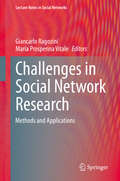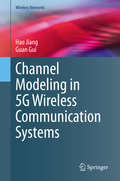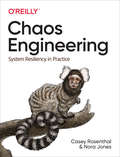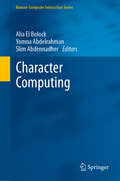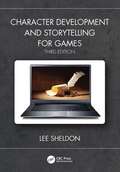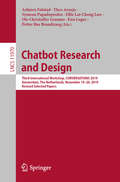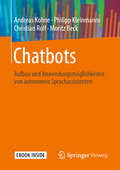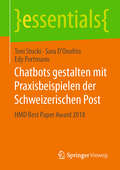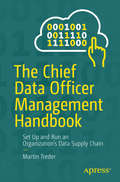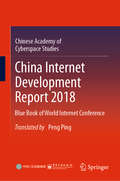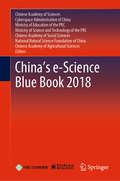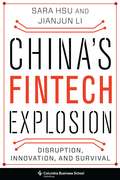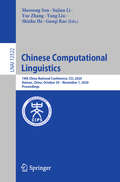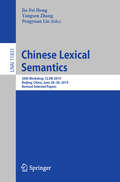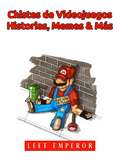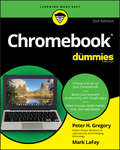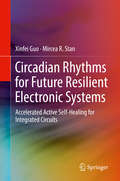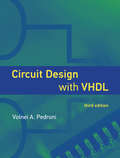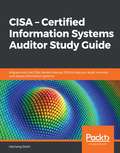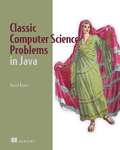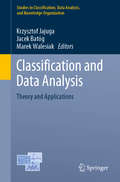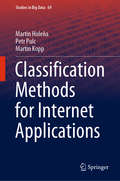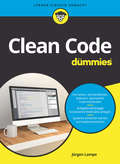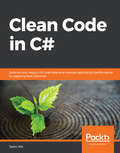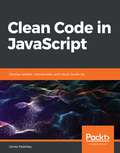- Table View
- List View
Challenges in Social Network Research: Methods and Applications (Lecture Notes in Social Networks)
by Giancarlo Ragozini Maria Prosperina VitaleThe book includes both invited and contributed chapters dealing with advanced methods and theoretical development for the analysis of social networks and applications in numerous disciplines. Some authors explore new trends related to network measures, multilevel networks and clustering on networks, while other contributions deepen the relationship among statistical methods for data mining and social network analysis. Along with the new methodological developments, the book offers interesting applications to a wide set of fields, ranging from the organizational and economic studies, collaboration and innovation, to the less usual field of poetry. In addition, the case studies are related to local context, showing how the substantive reasoning is fundamental in social network analysis. The list of authors includes both top scholars in the field of social networks and promising young researchers. All chapters passed a double blind review process followed by the guest editors. This edited volume will appeal to students, researchers and professionals.
Channel Modeling in 5G Wireless Communication Systems (Wireless Networks)
by Guan Gui Hao JiangThis book addresses the fundamental design and technical challenges for fifth generation (5G) wireless channel models, including multi-frequency bands and multi-scenarios. The book presents a strong vision for 5G wireless communication networks based on current market trends, proven technologies, and future directions. The book helps enable researchers and industry professionals to come up with novel ideas in the area of wireless heterogeneity, to minimize traffic accidents, to improve traffic efficiency, and to foster the development of new applications such as mobile infotainment. The book acts as a comprehensive reference for students, instructors, researchers, engineers, and other professionals, building their understanding of 5G and in designing 5G systems.Addresses fundamental design and technical challenges for 5G wireless channel models;Presents how to create reliable statistical channel models to capture the propagation properties between transmitters and receivers;Pertinent to researchers, engineers, and professionals in 5G.
Chaos Engineering: System Resiliency in Practice
by Casey Rosenthal Nora JonesAs more companies move toward microservices and other distributed technologies, the complexity of these systems increases. You can’t remove the complexity, but through Chaos Engineering you can discover vulnerabilities and prevent outages before they impact your customers. This practical guide shows engineers how to navigate complex systems while optimizing to meet business goals.Two of the field’s prominent figures, Casey Rosenthal and Nora Jones, pioneered the discipline while working together at Netflix. In this book, they expound on the what, how, and why of Chaos Engineering while facilitating a conversation from practitioners across industries. Many chapters are written by contributing authors to widen the perspective across verticals within (and beyond) the software industry.Learn how Chaos Engineering enables your organization to navigate complexityExplore a methodology to avoid failures within your application, network, and infrastructureMove from theory to practice through real-world stories from industry experts at Google, Microsoft, Slack, and LinkedIn, among othersEstablish a framework for thinking about complexity within software systemsDesign a Chaos Engineering program around game days and move toward highly targeted, automated experimentsLearn how to design continuous collaborative chaos experiments
Character Computing (Human–Computer Interaction Series)
by Alia El Bolock Yomna Abdelrahman Slim AbdennadherThe book gives an introduction into the theory and practice of the transdisciplinary field of Character Computing, introduced by Alia El Bolock. The latest scientific findings indicate that “One size DOES NOT fit all” in terms of how to design interactive systems and predict behavior to tailor the interaction experience. Emotions are one of the essential factors that influence people’s daily experiences; they influence decision making and how different emotions are interpreted by different individuals. For example, some people may perform better under stress and others may break. Building upon Rosalind Picard’s vision, if we want computers to be genuinely intelligent and to interact naturally with us, we must give computers the ability to recognize, understand, even to have and express emotions and how different characters perceive and react to these emotions, hence having richer and truly tailored interaction experiences. Psychological processes or personality traits are embedded in the existing fields of Affective and Personality Computing. However, this book is the first that systematically addresses this including the whole human character; namely our stable personality traits, our variable affective, cognitive and motivational states as well as our morals, beliefs and socio-cultural embedding. The book gives an introduction into the theory and practice of the transdisciplinary field of Character Computing. The emerging field leverages Computer Science and Psychology to extend technology to include the whole character of humans and thus paves the way for researchers to truly place humans at the center of any technological development. Character Computing is presented from three main perspectives: ● Profiling and sensing the character ● Leveraging characters to build ubiquitous character-aware systems ● Investigating how to extend Artificial Intelligence to create artificial characters
Character Development and Storytelling for Games
by Lee SheldonThis is the third edition of Character Development and Storytelling for Games, a standard work in the field that brings all of the teaching from the first two books up to date and tackles the new challenges of today. Professional game writer and designer Lee Sheldon combines his experience and expertise in this updated edition. New examples, new game types, and new challenges throughout the text highlight the fundamentals of character writing and storytelling. But this book is not just a box of techniques for writers of video games. It is an exploration of the roots of character development and storytelling that readers can trace from Homer to Chaucer to Cervantes to Dickens and even Mozart. Many contemporary writers also contribute insights from books, plays, television, films, and, yes, games. Sheldon and his contributors emphasize the importance of creative instinct and listening to the inner voice that guides successful game writers and designers. Join him on his quest to instruct, inform, and maybe even inspire your next great game.
Chatbot Research and Design: Third International Workshop, CONVERSATIONS 2019, Amsterdam, The Netherlands, November 19–20, 2019, Revised Selected Papers (Lecture Notes in Computer Science #11970)
by Symeon Papadopoulos Asbjørn Følstad Theo Araujo Effie Lai-Chong Law Ole-Christoffer Granmo Ewa Luger Petter Bae BrandtzaegThis book constitutes the refereed proceedings of the Third International Workshop on Chatbot Research and Design, CONVERSATIONS 2019, held in Amsterdam, The Netherlands, in November 2019. The 18 revised full papers presented in this volume were carefully reviewed and selected from 31 submissions.The papers are grouped in the following topical sections: user and communication studies user experience and design, chatbots for collaboration, chatbots for customer service, and chatbots in education.
Chatbots: Aufbau und Anwendungsmöglichkeiten von autonomen Sprachassistenten
by Andreas Kohne Philipp Kleinmanns Christian Rolf Moritz BeckChatbots setzen sich in vielen Bereichen für die Kommunikation mit Kunden, Mitarbeitern und Bürgern durch. Sie beantworten automatisch Anfragen, entlasten Hotlines oder beraten Kunden. In diesem Buch werden die technischen wie auch die sprachlichen Grundlagen von Chatbots ausführlich vorgestellt und anhand von praxisnahen Beispielen erläutert. Weiterhin werden wichtige Aspekte wie Kosten, Akzeptanz und rechtliche Grundlagen beleuchtet. Abschließend wird anhand eines konkreten Beispiels ein Chatbot-Projekt exemplarisch beschrieben.
Chatbots gestalten mit Praxisbeispielen der Schweizerischen Post: HMD Best Paper Award 2018 (essentials)
by Toni Stucki Sara D’Onofrio Edy PortmannImmer mehr Unternehmen bauen Chatbots, damit ihre Kunden und Mitarbeiter in natürlicher Sprache mit den Systemen des Unternehmens kommunizieren können. Mittels Chatbots können dialogintensive Prozesse automatisiert und neue Wissensquellen erschlossen werden. Das vorliegende essential führt die Grundlagen von Chatbots ein und zeigt mit Praxisbeispielen der Schweizerischen Post, wo sie angewendet werden können, worauf bei ihrer Gestaltung geachtet werden muss und welche neuen Fähigkeiten in einem Unternehmen für deren Einsatz erforderlich sind.Die Autoren:Toni Stucki hat langjährige Erfahrungen als Softwarearchitekt. Bei der Schweizerischen Post leitet er ein Softwareentwicklungsteam, mit dem er bereits mehrere Chatbots implementiert hat. Dr. Sara D’Onofrio arbeitete als Innovation-Managerin bei der Schweizerischen Post und war bei der Chatbot-Entwicklung der IT Post mit dabei. In ihrer Dissertation beschäftigte sie sich mit der Thematik Chatbots. Prof. Dr. Edy Portmann ist Swiss Post Professor of Computer Science am Human-IST Institut der Universität Freiburg i.Üe., Schweiz, und beschäftigt sich mit Fragen rund um Informationssysteme, -verarbeitung und -beschaffung.
The Chief Data Officer Management Handbook: Set Up and Run an Organization’s Data Supply Chain
by Martin TrederThere is no denying that the 21st century is data driven, with many digital industries relying on careful collection and analysis of mass volumes of information. A Chief Data Officer (CDO) at a company is the leader of this process, making the position an often daunting one. The Chief Data Officer Management Handbook is here to help.With this book, author Martin Treder advises CDOs on how to be better prepared for their swath of responsibilities, how to develop a more sustainable approach, and how to avoid the typical pitfalls. Based on positive and negative experiences shared by current CDOs, The Chief Data Officer Management Handbook guides you in designing the ideal structure of a data office, implementing it, and getting the right people on board.Important topics such as the data supply chain, data strategy, and data governance are thoughtfully covered by Treder. As a CDO it is important to use your position effectively with your entire team. The Chief Data Officer Management Handbook allows all employees to take ownership in data collaboration. Data is the foundation of present and future tech innovations, and you could be the leader that makes the next big impact.What You Will LearnApply important elements of effective data managementGain a comprehensive overview of all areas of data (which are often managed independently Work with the data supply chain, from data acquisition to its usage, a review of all relevant stakeholders, data strategy, and data governanceWho This Book is ForCDOs, data executives, data advisors, and all professionals looking to understand about how a data office functions in an organization.
China Internet Development Report 2018: Blue Book of World Internet Conference
by Chinese Academy of Cyberspace StudiesThis book is an important outcome of the Fifth World Internet Conference. It provides a comprehensive review of China’s Internet development, especially the new practice and achievement in 2018. And it offers a systematic account of China’s experience in Internet development and governance. This year, the book improves China’s Internet Development Index System, optimizes the algorithm model, and enhances data collection, to assess and reflect Internet development more comprehensively, objectively and scientifically.
China’s e-Science Blue Book 2018
by Chinese Academy of Sciences Cyberspace Administration of China Ministry of Education of the PRC Ministry of Science Technology of the PRC Chinese Academy of Social Sciences National Natural Science Foundation of China Chinese Academy of Agricultural SciencesThis book is jointly compiled by Chinese Academy of Sciences, Cyberspace Administration of China, Ministry of Education of the People’s Republic of China, Ministry of Science and Technology of the People’s Republic of China, Chinese Academy of Social Sciences, National Natural Science Foundation of China and Chinese Academy of Agricultural Sciences. Over the past several years, Chinese scholars have contributed numerous research works on the development of Chinese scientific information and technology, and produced a range of outstanding achievements. Focusing on the main topic of e-Science, this book explores the forefront of science and technology around the globe, the major demands in China and the main fields in China’s economic development. Furthermore, it reviews the major achievements and the typical cases in China's e-Science research. It provides a valuable reference source for future technological innovations and will introduce researchers and students in the area of e-Science to the latest results in China.
China's Fintech Explosion: Disruption, Innovation, and Survival
by Sara Hsu Jianjun LiFinancial technology—or fintech—is gaining in popularity globally as a way of making financial services more efficient and accessible. In rapidly developing China, fintech is taking off, catering to markets that state-owned banks and an undersized financial sector do not serve amid a backdrop of growing consumption and a large, tech-savvy millennial generation. It is becoming increasingly likely that some of China’s fintech firms will change the way the world does business.In China’s Fintech Explosion, Sara Hsu and Jianjun Li explore the transformative potential of China’s financial-technology industry, describing the risks and rewards for participants as well as the impact on consumers. They cover fintech’s many subsectors, such as digital payment systems, peer-to-peer lending and crowdfunding, credit card issuance, internet banks, blockchain finance and virtual currencies, and online insurance. The book highlights the disruption of traditional banking as well as the risks of fintech and regulatory technology. Hsu and Li describe major companies including Alipay and Tencent, developer of WeChat Pay and a wealth-management business, and other leading fintech firms such as Creditease, Zhong An Insurance, and JD Finance. Offering expert analysis of market potential, risks, and competition, as well as case studies of firms and consumer behavior, China’s Fintech Explosion is a must-read for anyone interested in one of the world’s breakout sectors.
Chinese Computational Linguistics: 19th China National Conference, CCL 2020, Hainan, China, October 30 – November 1, 2020, Proceedings (Lecture Notes in Computer Science #12522)
by Maosong Sun Sujian Li Yue Zhang Yang Liu Shizhu He Gaoqi RaoThis book constitutes the proceedings of the 19th China National Conference on Computational Linguistics, CCL 2020, held in Hainan, China, in October/November 2020.The 32 full and 2 short papers presented in this volume were carefully reviewed and selected from 99 submissions. They were organized in topical sections named: fundamental theory and methods of computational linguistics; information retrieval, dialogue and question answering; text generation and summarization; knowledge graph and information extraction; machine translation and multilingual information processing; minority language information processing; language resource and evaluation; social computing and sentiment analysis; and NLP applications.
Chinese Lexical Semantics: 20th Workshop, CLSW 2019, Beijing, China, June 28–30, 2019, Revised Selected Papers (Lecture Notes in Computer Science #11831)
by Jia-Fei Hong Yangsen Zhang Pengyuan LiuThis book constitutes the thoroughly refereed post-workshop proceedings of the 20th Chinese Lexical Semantics Workshop, CLSW 2019, held in Chiayi, Taiwan, in June 2019. The 39 full papers and 46 short papers included in this volume were carefully reviewed and selected from 254 submissions. They are organized in the following topical sections: lexical semantics; applications of natural language processing; lexical resources; corpus linguistics.
Chistes de Videojuegos, Historias, Memes & Más
by Leet EmperorEsta guía te ayudará a apender a contar chistes sobre videojuegos. Por eso, esta guía se enfoca en formas y métodos naturales para ofrecer los mejores resultados y sin efectos secundarios. Este libro te enseñará lo siguiente: - chistes de videojuegos - memes de videojuegos - contar buenos chistes Si quieres aprender a contar chistes sobre videojuegos, este libro es para ti.
Chromebook For Dummies
by Peter H. GregoryGet the most out of your Google Chromebook Chromebook For Dummies walks you through setting up your Chromebook, transitioning from traditional computers, customizing a Chromebook to fit your needs, navigating the many apps and their uses, and applying advanced settings and features. This book documents the features of all Chromebooks, approaching them from the point of view of a smart person who is intimidated by the technology. Offers extensive and practical information Covers all portable computers powered by Chrome OS Helps make it easy to drive these fast, user-friendly devices Includes coverage of the latest features in the Chrome operating system You’ll end up keeping this book close at hand, referring to it often as you explore the features of your Chromebook.
Circadian Rhythms for Future Resilient Electronic Systems: Accelerated Active Self-Healing for Integrated Circuits
by Xinfei Guo Mircea R. StanThis book describes methods to address wearout/aging degradations in electronic chips and systems, caused by several physical mechanisms at the device level. The authors introduce a novel technique called accelerated active self-healing, which fixes wearout issues by enabling accelerated recovery. Coverage includes recovery theory, experimental results, implementations and applications, across multiple nodes ranging from planar, FD-SOI to FinFET, based on both foundry provided models and predictive models. Presents novel techniques, tested with experiments on real hardware;Discusses circuit and system level wearout recovery implementations, many of these designs are portable and friendly to the standard design flow;Provides circuit-architecture-system infrastructures that enable the accelerated self-healing for future resilient systems;Discusses wearout issues at both transistor and interconnect level, providing solutions that apply to both;Includes coverage of resilient aspects of emerging applications such as IoT.
Circuit Design with VHDL, third edition (The\mit Press Ser.)
by Volnei A. PedroniA completely updated and expanded comprehensive treatment of VHDL and its applications to the design and simulation of real, industry-standard circuits.This comprehensive treatment of VHDL and its applications to the design and simulation of real, industry-standard circuits has been completely updated and expanded for the third edition. New features include all VHDL-2008 constructs, an extensive review of digital circuits, RTL analysis, and an unequaled collection of VHDL examples and exercises. The book focuses on the use of VHDL rather than solely on the language, with an emphasis on design examples and laboratory exercises.The third edition begins with a detailed review of digital circuits (combinatorial, sequential, state machines, and FPGAs), thus providing a self-contained single reference for the teaching of digital circuit design with VHDL. In its coverage of VHDL-2008, it makes a clear distinction between VHDL for synthesis and VHDL for simulation. The text offers complete VHDL codes in examples as well as simulation results and comments. The significantly expanded examples and exercises include many not previously published, with multiple physical demonstrations meant to inspire and motivate students. The book is suitable for undergraduate and graduate students in VHDL and digital circuit design, and can be used as a professional reference for VHDL practitioners. It can also serve as a text for digital VLSI in-house or academic courses.
CISA - Certified Information Systems Auditor Study Guide: Aligned with the CISA Review Manual 2019 to help you audit, monitor, and assess information systems
by Hemang DoshiThis CISA exam study guide is designed for those with a non-technical background who are interested in achieving CISA certification and are currently employed or looking to gain employment in IT audit and security management positions.
Classic Computer Science Problems in Java
by David KopecSharpen your coding skills by exploring established computer science problems! Classic Computer Science Problems in Java challenges you with time-tested scenarios and algorithms.Summary Sharpen your coding skills by exploring established computer science problems! Classic Computer Science Problems in Java challenges you with time-tested scenarios and algorithms. You&’ll work through a series of exercises based in computer science fundamentals that are designed to improve your software development abilities, improve your understanding of artificial intelligence, and even prepare you to ace an interview. As you work through examples in search, clustering, graphs, and more, you'll remember important things you've forgotten and discover classic solutions to your "new" problems! Purchase of the print book includes a free eBook in PDF, Kindle, and ePub formats from Manning Publications. About the technology Whatever software development problem you&’re facing, odds are someone has already uncovered a solution. This book collects the most useful solutions devised, guiding you through a variety of challenges and tried-and-true problem-solving techniques. The principles and algorithms presented here are guaranteed to save you countless hours in project after project. About the book Classic Computer Science Problems in Java is a master class in computer programming designed around 55 exercises that have been used in computer science classrooms for years. You&’ll work through hands-on examples as you explore core algorithms, constraint problems, AI applications, and much more. What's inside Recursion, memoization, and bit manipulation Search, graph, and genetic algorithms Constraint-satisfaction problems K-means clustering, neural networks, and adversarial search About the reader For intermediate Java programmers. About the author David Kopec is an assistant professor of Computer Science and Innovation at Champlain College in Burlington, Vermont. Table of Contents 1 Small problems 2 Search problems 3 Constraint-satisfaction problems 4 Graph problems 5 Genetic algorithms 6 K-means clustering 7 Fairly simple neural networks 8 Adversarial search 9 Miscellaneous problems 10 Interview with Brian Goetz
Classification and Data Analysis: Theory and Applications (Studies in Classification, Data Analysis, and Knowledge Organization)
by Krzysztof Jajuga Jacek Batóg Marek WalesiakThis volume gathers peer-reviewed contributions on data analysis, classification and related areas presented at the 28th Conference of the Section on Classification and Data Analysis of the Polish Statistical Association, SKAD 2019, held in Szczecin, Poland, on September 18–20, 2019. Providing a balance between theoretical and methodological contributions and empirical papers, it covers a broad variety of topics, ranging from multivariate data analysis, classification and regression, symbolic (and other) data analysis, visualization, data mining, and computer methods to composite measures, and numerous applications of data analysis methods in economics, finance and other social sciences. The book is intended for a wide audience, including researchers at universities and research institutions, graduate and doctoral students, practitioners, data scientists and employees in public statistical institutions.
Classification Methods for Internet Applications (Studies in Big Data #69)
by Martin Holeňa Petr Pulc Martin KoppThis book explores internet applications in which a crucial role is played by classification, such as spam filtering, recommender systems, malware detection, intrusion detection and sentiment analysis. It explains how such classification problems can be solved using various statistical and machine learning methods, including K nearest neighbours, Bayesian classifiers, the logit method, discriminant analysis, several kinds of artificial neural networks, support vector machines, classification trees and other kinds of rule-based methods, as well as random forests and other kinds of classifier ensembles. The book covers a wide range of available classification methods and their variants, not only those that have already been used in the considered kinds of applications, but also those that have the potential to be used in them in the future. The book is a valuable resource for post-graduate students and professionals alike.
Clean Code für Dummies (Für Dummies)
by Jürgen LampeClean Code ist eine wichtige Methode, um zu besserer Software zu kommen. Zu beachten sind Korrektheit, Verständlichkeit, Lesbarkeit und Ressourcenverbrauch. Programmieren ist aber mehr als ein Handwerk. Klarer Code ist auch Ausdruck klaren Denkens und beginnt damit schon vor der Niederschrift. Regeln sind wichtige Stützen, aber das eigenständige Denken, Entscheiden und Abwägen ersetzen sie nicht. Leider wird darüber fast nie gesprochen. Das Buch soll helfen, dieses Manko zu beseitigen. Es vermittelt handwerkliche Fertigkeiten, stellt das Programmieren aber gleichzeitig auch in den Gesamtprozess der Softwareentwicklung. Das entlastet Sie als Programmierer!
Clean Code in C#: Refactor your legacy C# code base and improve application performance by applying best practices
by Jason AllsDevelop your programming skills by exploring essential topics such as code reviews, implementing TDD and BDD, and designing APIs to overcome code inefficiency, redundancy, and other problems arising from bad code Key Features Write code that cleanly integrates with other systems while maintaining well-defined software boundaries Understand how coding principles and standards enhance software quality Learn how to avoid common errors while implementing concurrency or threading Book Description Traditionally associated with developing Windows desktop applications and games, C# is now used in a wide variety of domains, such as web and cloud apps, and has become increasingly popular for mobile development. Despite its extensive coding features, professionals experience problems related to efficiency, scalability, and maintainability because of bad code. Clean Code in C# will help you identify these problems and solve them using coding best practices. The book starts with a comparison of good and bad code, helping you understand the importance of coding standards, principles, and methodologies. You'll then get to grips with code reviews and their role in improving your code while ensuring that you adhere to industry-recognized coding standards. This C# book covers unit testing, delves into test-driven development, and addresses cross-cutting concerns. You'll explore good programming practices for objects, data structures, exception handling, and other aspects of writing C# computer programs. Once you've studied API design and discovered tools for improving code quality, you'll look at examples of bad code and understand which coding practices you should avoid. By the end of this clean code book, you'll have the developed skills you need in order to apply industry-approved coding practices to write clean, readable, extendable, and maintainable C# code. What you will learn Write code that allows software to be modified and adapted over time Implement the fail-pass-refactor methodology using a sample C# console application Address cross-cutting concerns with the help of software design patterns Write custom C# exceptions that provide meaningful information Identify poor quality C# code that needs to be refactored Secure APIs with API keys and protect data using Azure Key Vault Improve your code's performance by using tools for profiling and refactoring Who this book is for This coding book is for C# developers, team leads, senior software engineers, and software architects who want to improve the efficiency of their legacy systems. A strong understanding of C# programming is required.
Clean Code in JavaScript: Develop reliable, maintainable, and robust JavaScript
by James PadolseyGet the most out of JavaScript for building web applications through a series of patterns, techniques, and case studies for clean coding Key Features Write maintainable JS code using internal abstraction, well-written tests, and well-documented code Understand the agents of clean coding like SOLID principles, OOP, and functional programming Explore solutions to tackle common JavaScript challenges in building UIs, managing APIs, and writing states Book Description Building robust apps starts with creating clean code. In this book, you'll explore techniques for doing this by learning everything from the basics of JavaScript through to the practices of clean code. You'll write functional, intuitive, and maintainable code while also understanding how your code affects the end user and the wider community. The book starts with popular clean-coding principles such as SOLID, and the Law of Demeter (LoD), along with highlighting the enemies of writing clean code such as cargo culting and over-management. You'll then delve into JavaScript, understanding the more complex aspects of the language. Next, you'll create meaningful abstractions using design patterns, such as the Class Pattern and the Revealing Module Pattern. You'll explore real-world challenges such as DOM reconciliation, state management, dependency management, and security, both within browser and server environments. Later, you'll cover tooling and testing methodologies and the importance of documenting code. Finally, the book will focus on advocacy and good communication for improving code cleanliness within teams or workplaces, along with covering a case study for clean coding. By the end of this book, you'll be well-versed with JavaScript and have learned how to create clean abstractions, test them, and communicate about them via documentation. What you will learn Understand the true purpose of code and the problems it solves for your end-users and colleagues Discover the tenets and enemies of clean code considering the effects of cultural and syntactic conventions Use modern JavaScript syntax and design patterns to craft intuitive abstractions Maintain code quality within your team via wise adoption of tooling and advocating best practices Learn the modern ecosystem of JavaScript and its challenges like DOM reconciliation and state management Express the behavior of your code both within tests and via various forms of documentation Who this book is for This book is for anyone who writes JavaScript, professionally or otherwise. As this book does not relate specifically to any particular framework or environment, no prior experience of any JavaScript web framework is required. Some knowledge of programming is assumed to understand the concepts covered in the book more effectively.
